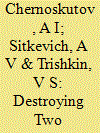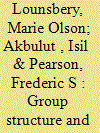| Srl | Item |
| 1 |
ID:
170945


|
|
|
|
|
| Summary/Abstract |
The authors present a new method of destroying two heterogeneous groups by comparing their combat superiority coefficients. Examples demonstrate this method's efficiency and in certain cases, its application as the sole option of attaining victory
|
|
|
|
|
|
|
|
|
|
|
|
|
|
|
|
| 2 |
ID:
152886


|
|
|
|
|
| Summary/Abstract |
Studies have begun to look at the potentially crucial impacts of group decentralization and inter-group global networking in accounting for the extent and severity of violence in insurgencies and terrorism. Groups may be able to survive more effectively, evade anti-terror or counter-insurgency strategies, and inflict greater damage or more civilian attacks by operating under more or less centralized leadership, or by making use of the resources of other like-minded groups scattered across borders. While some analysts have examined each of these possibilities, few if any have done so simultaneously with both structural and networking indicators or examined the joint effects of these indicators. We propose to do so in this study by combining existing datasets on terrorist structure and networks. Hypotheses and findings in prior studies have indicated that structural decentralization may lead to more civilian attacks if not more destruction since local cells are freer to act on their own, and that group size and centrality in the global terror networks lead to greater lethality and group survival rates. We re-examine such assumptions here with OLS and logit models combining these effects, and find that in addition to group size, network reach (eigenvalue centrality) rather than group interconnections per se (number of allies) appears to have primary impacts on group lethality, targeting, and survival, sometimes in conjunction with decentralized organizational structure.
|
|
|
|
|
|
|
|
|
|
|
|
|
|
|
|